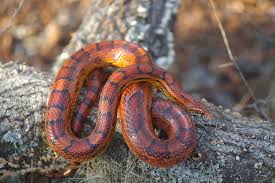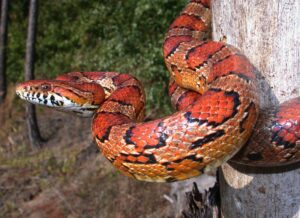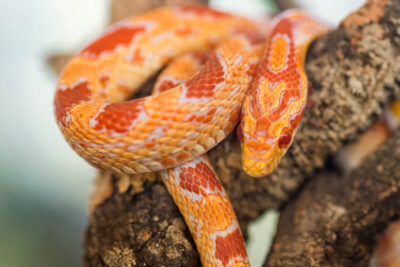Curiosity about pet snakes often leads enthusiasts to explore various aspects of snake behavior, and one common question that arises is, ‘Does a corn snake bite?’ These vibrant and popular reptiles are a favorite among snake enthusiasts, thanks to their docile nature and captivating appearance.
In this article, we delve into the intriguing question surrounding corn snakes and their tendency to bite, shedding light on the factors that influence their behavior and offering insights into the unique characteristics of these captivating serpents.
Common misconceptions about corn snake behavior

Corn snakes (Pantherophis guttatus) are popular pet snakes known for their docile nature, manageable size, and attractive coloration.
However, there are some common misconceptions about corn snake behavior that should be clarified:
- Aggressiveness: One major misconception is that corn snakes are aggressive. In reality, corn snakes are generally docile and non-aggressive. While any snake may strike defensively if it feels threatened, corn snakes are not known for being overly aggressive. With regular handling and proper care, they can become quite tame.
- Constriction: Some people mistakenly believe that corn snakes are constrictors like larger snake species such as pythons or boas. Corn snakes are not true constrictors; they primarily rely on their sharp teeth to subdue and consume prey. While they may wrap around their prey to some extent, it is not the same as the powerful constriction seen in larger snake species.
- Venom: Corn snakes are non-venomous. There’s a misconception that all snakes are venomous, but corn snakes do not produce venom. They rely on constriction and swallowing prey whole to consume their food.
- Need for Large Enclosures: Corn snakes are relatively small compared to some other snake species, and they do not require excessively large enclosures. An appropriately sized enclosure with hiding spots, a water bowl, and a temperature gradient is usually sufficient for their well-being.
- Nocturnal Behavior: While corn snakes are crepuscular, meaning they are most active during dawn and dusk, they are not strictly nocturnal. They may exhibit activity during the day, especially if they are hunting or basking in a warm spot.
- Social Animals: Corn snakes are solitary animals and do not require companionship. Keeping multiple snakes in the same enclosure can lead to stress, competition for resources, and potential aggression.
- Always Hungry: It’s a common misconception that snakes are always hungry. In reality, corn snakes, like many other snakes, have a natural feeding schedule and may refuse food for various reasons, including shedding, stress, or temperature fluctuations. Overfeeding can lead to obesity and other health issues.
- Handling Stress: While corn snakes can become accustomed to handling, it’s essential to recognize signs of stress. Handling should be done gently and for reasonable durations. Snakes may become stressed if handled too frequently or if they are in an unfamiliar environment.
Understanding the natural behavior of corn snakes and providing them with appropriate care and handling will contribute to a positive relationship between the snake and its owner.
Corn Snake Temperament
Corn snakes are well-regarded for their generally calm and docile temperament, making them popular choices as pets for snake enthusiasts, including beginners.
Here are some key points about corn snake temperament:
- Docility: Corn snakes are known for their docile nature. With regular, gentle handling, they often become quite comfortable with human interaction. They are less likely to bite compared to some other snake species.
- Tolerance of Handling: Corn snakes typically tolerate handling well, and many individuals become quite relaxed when being held. However, it’s essential to approach them calmly and avoid sudden movements to prevent stress.
- Rarely Aggressive: Corn snakes are not known for being aggressive. While any snake may strike defensively if it feels threatened, corn snakes are more likely to rely on hiding or attempting to escape when they perceive a potential threat.
- Handling Frequency: While corn snakes can become accustomed to handling, it’s crucial not to overdo it. Like any animal, they need some time to rest and may become stressed if handled excessively. Short, regular handling sessions are often more beneficial than extended periods.
- Individual Variability: It’s important to note that individual corn snakes may have varying temperaments. Some may be naturally more outgoing and accepting of handling, while others may be a bit more reserved. This can depend on factors such as genetics, early experiences, and individual personality.
- Feeding Response: Corn snakes are known for their strong feeding response. However, this should not be confused with aggression. When reaching into the enclosure, they may strike out of hunger, thinking that your hand is food. Feeding should be done in a separate container to avoid accidental bites.
- Stress Indicators: Signs of stress in a corn snake can include rapid breathing, hissing, attempting to escape, or defensive posturing. It’s crucial to be aware of these signs and give the snake time to acclimate to its environment and handler.
Remember that each snake is an individual, and there may be variations in temperament even within the same species. Proper care, a suitable environment, and respectful handling contribute to a positive relationship between a corn snake and its owner.
Always approach handling with patience and gentleness to build trust and ensure the well-being of the snake.
Does a corn snake bite?
Yes, like any snake, a corn snake is capable of biting. However, corn snakes are known for their generally docile nature, and they are less prone to biting compared to some other snake species. In most cases, a corn snake will try to avoid confrontation and may exhibit defensive behaviors, such as hiding or attempting to flee, rather than resorting to biting.
Bites from corn snakes are usually not dangerous to humans. Their teeth are relatively small and not designed to inject venom. A bite from a corn snake may cause some minor discomfort, such as puncture wounds or scratches, but it’s not likely to result in serious injury.
It’s important to note that there are various reasons a snake might bite, and understanding these factors can help reduce the likelihood of it happening. Some common reasons for a snake, including a corn snake, to bite include:
- Feeding Response: If a snake mistakes a hand for food, especially during feeding time, it may strike out of hunger. This is why it’s recommended to use separate feeding containers to avoid accidental bites.
- Stress or Fear: If a snake feels threatened or stressed, it may resort to defensive behaviors, including biting, as a means of protecting itself.
- Health Issues: Unwell or injured snakes may be more prone to defensive behaviors, including biting.
- Handling Mistakes: Rough or sudden handling can startle or stress a snake, leading to defensive reactions.
To minimize the risk of a bite, it’s crucial to handle a corn snake gently and consistently, allowing it to become accustomed to human interaction.
Additionally, being aware of the snake’s behavior, providing a secure and appropriate environment, and respecting its need for privacy can contribute to a positive and low-stress relationship between the snake and its owner.
Factors That May Lead to corn snake Biting

Several factors can contribute to a snake, including a corn snake, exhibiting biting behavior. It’s important for snake owners to be aware of these factors to reduce the risk of bites and promote a positive interaction with their pet.
Here are some key factors that may lead to biting:
- Feeding Response: One of the most common reasons for bites is a feeding response. Snakes may mistake a hand for food, especially if the owner’s hand smells like the prey they associate with feeding. To avoid this, it’s recommended to use separate feeding containers and wash hands thoroughly before handling the snake.
- Stress and Fear: Snakes can become stressed or frightened in certain situations. Rapid or forceful handling, sudden movements, loud noises, or unfamiliar environments can trigger stress responses, including defensive behaviors like biting. It’s essential to handle the snake calmly and gently to minimize stress.
- Illness or Injury: Sick or injured snakes may be more prone to defensive behaviors, including biting. If a snake is not feeling well, it may become more agitated and defensive. Regular veterinary check-ups and prompt attention to any signs of illness are important.
- Protecting Eggs or Young: Female snakes, especially when guarding eggs or newly hatched offspring, may become more defensive and protective. It’s crucial to exercise caution and give them space during these times.
- Territorial Behavior: Some snakes may exhibit territorial behavior, especially if they perceive an intrusion into their space. This can happen when reaching into the snake’s enclosure, particularly if it feels cornered or threatened.
- Hunger: While not as common in well-fed captive snakes, hunger can still be a factor in defensive behavior. Snakes that are not fed on a regular schedule or are underfed may be more likely to strike out of hunger.
- Shedding: Snakes can be more irritable and defensive during the shedding process. The skin becomes more sensitive, and handling may cause discomfort, leading to defensive behaviors.
Signs of Aggression or Discomfort for corn snakes
While corn snakes are generally docile, there are signs that may indicate they are feeling stressed, uncomfortable, or defensive. Understanding these signs can help snake owners respond appropriately to prevent bites and ensure the well-being of the snake.
Here are some common signs of aggression or discomfort in corn snakes:
- Hissing: While not all corn snakes will hiss, it can be a sign of stress or discomfort. If a corn snake hisses, it may be feeling threatened, and it’s essential to give it space.
- Striking: A snake may strike if it feels cornered or threatened. This is a defensive behavior, and the snake may be attempting to deter a perceived threat.
- Curling into a Ball: Corn snakes may adopt a defensive posture by coiling into a ball when they feel threatened. This is a way for them to protect their head and vital organs.
- Tail Vibrations: Some snakes, including corn snakes, may vibrate their tails when they feel threatened. This behavior is not aggression per se but is a sign of distress or discomfort.
- Hiding: If a corn snake retreats to a hiding spot and refuses to come out, it may be feeling stressed or uncomfortable. Providing a secure hiding place in the snake’s enclosure is essential for them to have a retreat when needed.
- Puffing Up: Corn snakes may puff up their bodies to appear larger when they feel threatened. This behavior is part of their defensive display to deter potential predators.
- Agitated Movements: Rapid or jerky movements can indicate that a snake is agitated or stressed. It’s crucial to move slowly and calmly when handling corn snakes to avoid triggering defensive responses.
- Wide-mouth Defensive Posture: Some corn snakes may adopt a wide-mouth defensive posture, opening their mouths wide to appear more intimidating. This behavior is a clear sign of discomfort or feeling threatened.
- Defensive Strikes During Handling: If a corn snake repeatedly strikes or tries to bite during handling, it may be expressing discomfort or a lack of tolerance for handling. In such cases, it’s advisable to limit handling and give the snake time to acclimate gradually.
Preventing Bites for corn snakes

Preventing bites from corn snakes involves understanding their behavior, providing appropriate care, and handling them in a way that minimizes stress.
Here are some tips to help prevent bites from corn snakes:
- Handle Gradually: If your corn snake is new or hasn’t been handled much, start with short and infrequent handling sessions. Gradually increase the duration and frequency as the snake becomes more accustomed to being handled.
- Wash Hands: Before handling your corn snake, wash your hands thoroughly to remove any scents that may trigger a feeding response. Snakes can sometimes mistake the scent of food for your hand.
- Be Calm and Gentle: Approach your corn snake calmly and move slowly. Sudden movements can startle the snake, leading to defensive behavior. Handling should be a gentle and positive experience for the snake.
- Avoid Disturbing While Eating: Do not handle your corn snake immediately before or after feeding. Snakes can be more defensive or agitated during these times.
- Learn Body Language: Pay attention to your snake’s body language. Signs of stress or discomfort may include hissing, tail vibrations, defensive postures, and rapid movements. If you notice these signs, it’s best to give the snake some space.
- Use Proper Handling Techniques: Support the snake’s body properly and avoid grabbing or restraining it too tightly. Allow the snake to move freely over your hands and arms.
- Respect Their Space: Give your corn snake adequate hiding spots in its enclosure. Corn snakes may feel stressed if they don’t have a secure place to retreat to when they feel the need.
- Handle During Calm Periods: Corn snakes are naturally more active during dawn and dusk. Handling them during these calmer periods may reduce stress.
- Provide a Suitable Environment: Ensure that your snake’s enclosure meets its needs in terms of temperature, humidity, hiding spots, and substrate. A comfortable and secure environment can contribute to a less stressed snake.
- Regular Health Checks: Keep an eye on your snake’s health. A snake in discomfort due to illness or injury may be more prone to defensive behavior.
- Avoid Aggressive Behavior: If your corn snake displays signs of aggression or discomfort, such as hissing, striking, or defensive posturing, avoid handling it until it calms down.
Remember that even with the best precautions, a snake might still bite in certain situations. If a bite does occur, stay calm and avoid jerking your hand away, as this can cause additional injury. Gently and slowly remove the snake from your hand.
By understanding and respecting the natural behavior of corn snakes, providing appropriate care, and using gentle handling techniques, you can create a positive and low-stress environment for your pet snake, reducing the likelihood of bites.
What to Do If Bitten by corn snake?
While corn snakes are non-venomous and their bites are generally not harmful, a bite can still be startling and may cause some minor discomfort. If you are bitten by a corn snake, here are the steps to take:
- Stay Calm:
-
- Keep in mind that corn snakes are not venomous, and their bites are usually not dangerous.
- Stay calm to avoid escalating the situation. Panicking can make it more difficult to handle the situation appropriately.
- Do Not Jerk Away:
-
- Avoid pulling your hand away quickly, as this can potentially cause additional injury. Corn snake teeth are small, and jerking away may tear the skin.
- Wait for Release:
-
- Corn snakes do not have a strong bite, and they typically release their grip relatively quickly. Wait for the snake to release its bite on its own.
- Gently Remove the Snake:
-
- Once the snake has released its bite, gently and slowly remove it from your hand or any other body part.
- Clean the Wound:
-
- Wash the bite area with mild soap and water to clean the wound and reduce the risk of infection.
- Apply Antiseptic:
-
- Apply an antiseptic ointment or cream to the bite area to further reduce the risk of infection.
- Monitor for Signs of Infection:
-
- Keep an eye on the bite site for any signs of infection, such as redness, swelling, or discharge. If you notice any concerning symptoms, seek medical attention.
- Seek Medical Attention if Necessary:
-
- While corn snake bites are usually not a cause for major concern, if you experience severe pain, swelling, or any signs of infection, it’s advisable to seek medical attention.
- Learn from the Experience:
-
- Consider what might have led to the bite and how you can prevent similar situations in the future. Assess your handling techniques and make adjustments if needed.
It’s important to note that bites from corn snakes are relatively rare, especially with proper handling and care. Taking the right steps after a bite can help ensure a smooth and uneventful recovery. If you have any concerns or if the bite appears to be more severe than a superficial wound, consult with a healthcare professional for guidance.
Conclusion
On this page, we have answer to the question does a corn snake bite. Corn snake is capable of biting, but bites are typically infrequent and not harmful to humans. Corn snakes are known for their generally docile nature, and with proper handling and care, the risk of bites can be minimized. Bites are usually a result of stress, fear, or mistaking a hand for food during feeding.
In the event of a bite, it’s important to remain calm, avoid jerking away, gently remove the snake, clean the wound, and monitor for signs of infection. Regular, gentle handling and understanding the snake’s behavior contribute to a positive and low-stress relationship with a pet corn snake.

